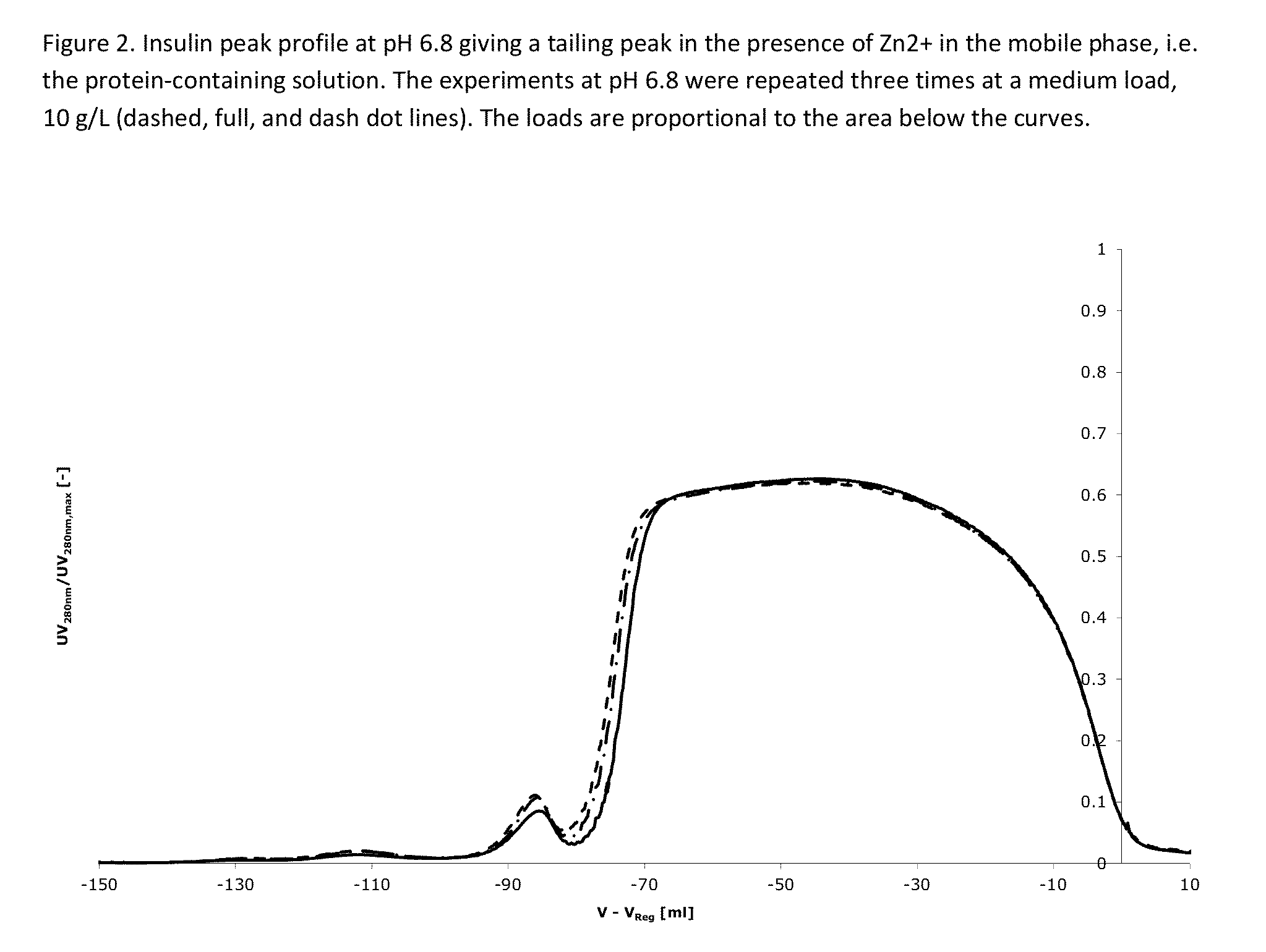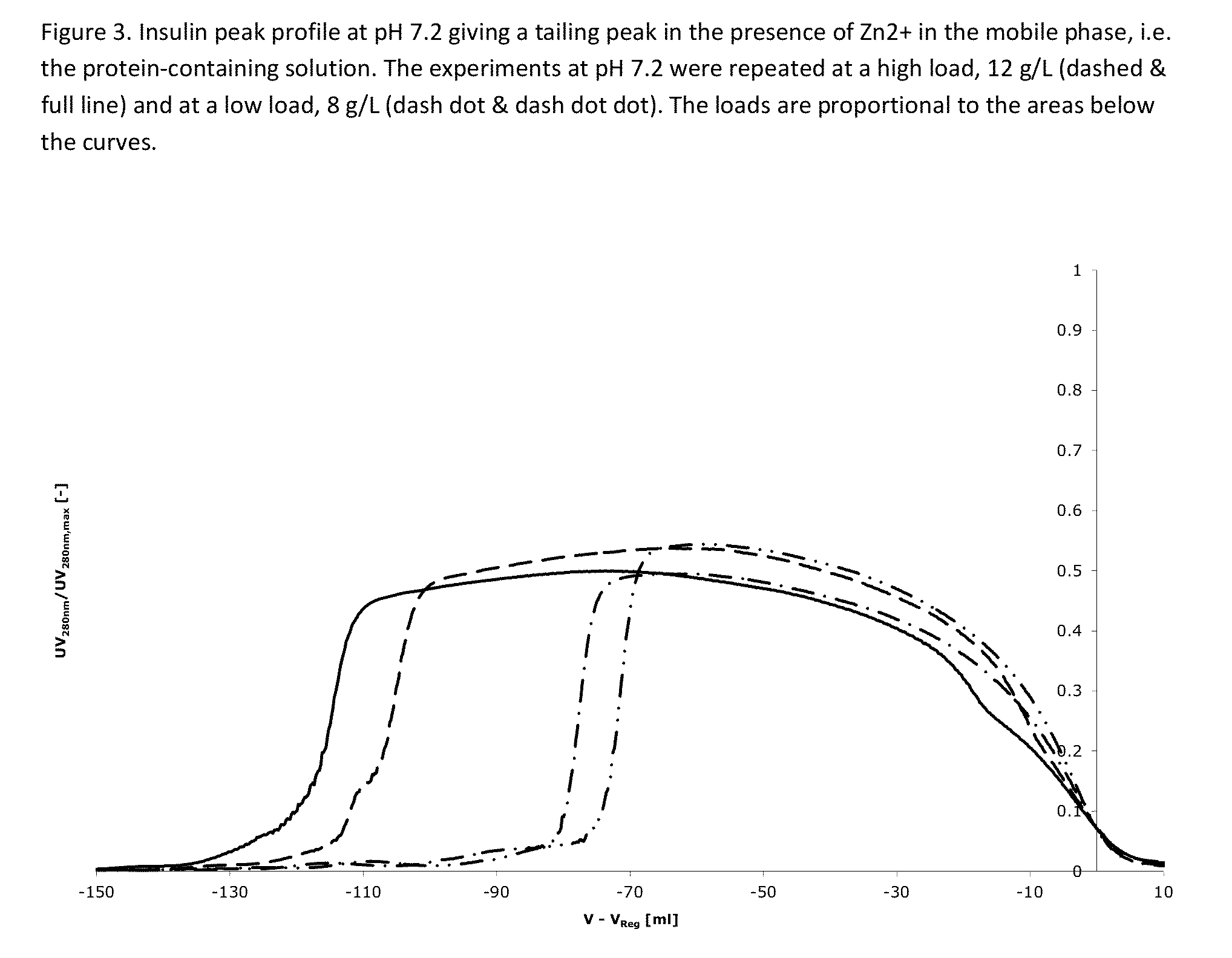Purification of insulin
a technology of purification and insulin, applied in the field of chromatographic process, can solve the problems of insufficient purity of a protein of interest, difficult removal or reduction of impurities, and difficult removal of impurities, and achieve the effect of improving the removal of impurities
- Summary
- Abstract
- Description
- Claims
- Application Information
AI Technical Summary
Benefits of technology
Problems solved by technology
Method used
Image
Examples
example 1
[0473]A column with the dimensions d=1 cm and L=25 cm is packed with Source 30Q from GE Healthcare.
[0474]A protein-containing solution containing 12 g / L insulin peptide (LysB29(Nε-hexadecandioyl-γ-Glu) des(B30) human insulin) (pI=4.7) in 30% EtOH, at pH=7.5 with a conductivity CV. The protein-containing solution contains Zn-ions in an amount of 2 zinc atoms per six insulin molecules.
[0475]Two buffer containing 42.5% ethanol, and 20 mM triethanolamine at pH=6.4, 6.8 and 7.2, containing 0 mM and 300 mM NH4Ac (Ammonium acetate) are used for elution. After the application of the protein-containing solution, the column is washed using one column volume of the solvent containing 0 mM NH4Ac and hereafter the protein is eluted using a salt gradient from 30 mM to 180 mM NH4Ac over 15 column volumes (see FIG. 1). Yields for all experiments were above 90%.
[0476]The result is shown in FIGS. 1-3 and further explained below.
[0477]FIG. 1: At pH 6.4 the impurity eluting before the main peak (at V−V...
example 2
[0480]An experiment was made where samples were taken out to analyse the content of Zn2+ in each of the fractions (see FIG. 4). These samples show that Zn is eluting together with the
[0481]
Content of Zn in collectedSamplefractions Zn2+ [mg / L]1. Fraction collected before related impurity0.2(fraction no. 12-23)2. Fraction collected at related impurity1.2eluting before main peak (fraction no. 45-47)3. Pool64. Fraction collected after the pool0.54(fraction no. 1-4)The numbers of the fractions in above table corresponds to the fractions shown in FIG. 4.
[0482]It is clearly seen that the Zn2+ is eluting together with the product.
[0483]The samples taken from a chromatographic run (sample 1-4) where Zn2+ was present in the feed but not in the eluents shows that Zn2+ is present in much higher concentration in the pool containing the product, where the concentration of the insulin analogue is the highest, compared to samples taken around the pool. This shows the strong interaction / cooperativit...
example 3
Analysis of Self-Association of Insulin by the SEC Method
[0488]The ability of insulin peptides to self-associate can be analysed by the SEC method. Analysis by size exclusion chromatography (SEC) on a Superose 6 PC column (0.32*30 cm) using isotonic 10 mM tris-buffered saline optionally added 2 mM phenol at 37° C. and pH 7.3, injection volume of 20 μL, flow of 0.05 mL / min and run time 130 min. First reference of Blue dextran (>>5 MDa, KAV 0.0), Thyroglobulin (669 kDa, KAV 0.28), Ferritin (440 kDa, KAV 0.39), Ovalbumin (44.5 kDa, KAV 0.56), Ribonuclease (13.7 kDa, KAV 0.69) and a second reference of Albumin (66 kDa, KAV 0.53), Co(III)insulin-hexamer (35 kDa, KAV 0.61), and monomeric insulin X2 (6 kDa, KAV 0.73). Retention time of blue dextran was 17.9 min (t0) and 0.74 min without column (td), and retention time of albumin (HSA) was about 34.1 min,
KAV=(t−t0) / (V / f+td−t0) with[0489]t: retention time (min)[0490]t0: retention time of blue dextran (exclusion limit)[0491]td: retention time...
PUM
 Login to View More
Login to View More Abstract
Description
Claims
Application Information
 Login to View More
Login to View More - R&D
- Intellectual Property
- Life Sciences
- Materials
- Tech Scout
- Unparalleled Data Quality
- Higher Quality Content
- 60% Fewer Hallucinations
Browse by: Latest US Patents, China's latest patents, Technical Efficacy Thesaurus, Application Domain, Technology Topic, Popular Technical Reports.
© 2025 PatSnap. All rights reserved.Legal|Privacy policy|Modern Slavery Act Transparency Statement|Sitemap|About US| Contact US: help@patsnap.com



